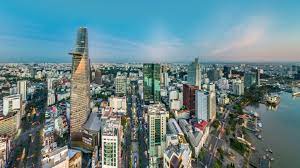Vietnam: A Rising Economic Power in Asia
1. Strategic Location and Trade Agreements
Vietnam’s geographical location is one of its greatest advantages. Situated in Southeast Asia, the country serves as a gateway to both the Pacific and Indian Oceans, making it an ideal trading hub. Additionally, Vietnam has actively pursued trade agreements with various countries, further enhancing its position in the global market.
Vietnam is a member of the Association of Southeast Asian Nations (ASEAN) and has signed free trade agreements with major economies such as Japan, South Korea, and the European Union. The most significant agreement is the Comprehensive and Progressive Agreement for Trans-Pacific Partnership (CPTPP), which includes 11 countries and covers a wide range of sectors. These trade agreements have opened up new opportunities for Vietnamese businesses, allowing them to access larger markets and attract foreign investment.
2. Manufacturing and Export Growth
Vietnam’s manufacturing sector has been a driving force behind its economic growth. The country has become a preferred destination for multinational corporations seeking to diversify their production bases. Low labor costs, coupled with a skilled workforce, have made Vietnam an attractive option for companies looking to reduce manufacturing expenses.
The electronics industry, in particular, has witnessed significant growth in Vietnam. Many global tech giants have set up production facilities in the country, taking advantage of its skilled labor force and favorable business environment. Vietnam has also emerged as a major exporter of textiles, footwear, and agricultural products.
3. Infrastructure Development
To support its economic growth, Vietnam has invested heavily in infrastructure development. The government has undertaken several large-scale projects, including the construction of highways, ports, and industrial parks. These infrastructure improvements have not only facilitated domestic trade but also enhanced connectivity with neighboring countries.
The development of industrial parks has been instrumental in attracting foreign investment. These parks offer investors ready-to-use facilities, streamlined administrative procedures, and access to a skilled labor pool. The government’s commitment to infrastructure development has created a conducive environment for businesses to thrive and has positioned Vietnam as an attractive investment destination.
4. Skilled Workforce and Education System
Vietnam boasts a young and dynamic workforce, with a median age of just 30 years. The country’s education system has played a crucial role in producing a skilled labor force that meets the demands of the modern economy. Vietnam has made significant progress in improving its education system, with a focus on science, technology, engineering, and mathematics (STEM) subjects.
Moreover, the Vietnamese government has implemented various initiatives to promote vocational training and technical education. These programs aim to equip workers with the necessary skills to meet industry requirements. As a result, Vietnam has been able to attract high-tech industries that require specialized knowledge and expertise.
Conclusion:
Vietnam’s rapid economic growth and increasing influence in Asia are undeniable. The country’s strategiclocation, favorable trade agreements, robust manufacturing sector, infrastructure development, and skilled workforce have all contributed to its rise as an economic powerhouse. As Vietnam continues to attract foreign investment and diversify its economy, it is poised to become one of the leading economies in the region. With its strong foundation and potential for further growth, Vietnam is undoubtedly a country to watch in the coming years.













Post Comment